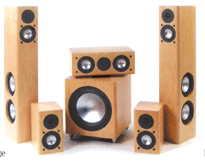
 RBH
speakers could be one of the electronics market's best-kept secrets. To
some people, these speakers may be nothing more than a name. However,
if the company keeps producing high-quality speakers at a number of
different price points, it may be hard for the sometimes opinionated
audiophile crowd to keep RBH's little secret quiet.
RBH
speakers could be one of the electronics market's best-kept secrets. To
some people, these speakers may be nothing more than a name. However,
if the company keeps producing high-quality speakers at a number of
different price points, it may be hard for the sometimes opinionated
audiophile crowd to keep RBH's little secret quiet.
This home theater speaker package combines some of the company's current offerings in the 641-SE, a new set of floor-standing main left and right speakers. This set further expands RBH's Signature Series speaker line. Joining the 641s are the 41-SE bookshelf speakers that are used as rear surrounds, the 441-SE center-channel speaker, and lastly the 12-SE, which is a 300-watt powered subwoofer.
Unique Features
Most speaker companies use some type of plastic or paper material in the construction of their woofers. RBH, on the other hand, chooses to use a rigid, proprietary aluminum. This choice is not just different, but makes it tempting to pull off the speaker grille and display the company's attractive drivers. For the tweeters, the company uses a more traditional silk dome material.
For listening to movie soundtracks, it is important for a company to timbre-match its speakers. One way to do this is to use identical drivers. RBH employs four-inch drivers and one-inch tweeters for the center and rear surrounds, with the 641s using the same one-inch tweeters for high frequencies.
Deviating from other speakers' two-way design and driver size, the 641-SE uses four-inch aluminum drivers for midrange frequencies, with larger side-firing woofers taking care of the lower bass frequencies. The results make the 641-SE a three-way design (each set of drivers reproduces a separate frequency band, determined by a crossover).
Installation Issues
Setting up the speakers couldn't be any easier. All of the speakers come with two sets of gold-plated binding posts. This gives the user the choice of bi-amping/biwiring the speakers. This means you can use separate amplifiers to power woofers and tweeters. It took a couple of minutes to connect our speaker cables, which are terminated with banana plugs. After that, we placed the speakers in the spot in the room where we thought they would sound best. It took a few minutes of "tweaking" the speaker placement to get what we thought was the best sound in our test room.
Finding the proper spot for the subwoofer was a more difficult task however. First we placed it in the corner. Normally corner placement of subwoofers augments the performance of the unit. The 12-SE proved to be too powerful, though, as even its lowest settings were too much for the room. Thirty minutes later, the sub ended up about a foot off the wall, placed about midway along the wall's length, with the volume control on the sub set at 10 o'clock.
Performance Testing
Whether it was movies or music, stereo or multichannel, these speakers projected a neutral sounding, detailed soundstage that placed snare and tom drums, vocals and guitar in the center of the listening area. The 641s were able to comfortably reproduce all of the music we ran through them. While not hitting the lowest of frequencies alone, with help from the subwoofer they will do anything that a majority of listeners will ask of them.
Moving on to multichannel music and movies highlighted another of the speaker's strengths: its tweeters. The one-inch tweeters had a nice balance to them in all situations. This aspect was especially true when listening to movies. Tough dialog scenes like the beginning of Gladiator were refreshingly audible through the 441-SE center channel. On a whole, the entire package worked well together, producing a perfectly seamless timbre-matched soundstage.
The Final Word
Today speaker companies are aware of the broad appeal of home theater. With that in mind, they take into account that many types of consumers will be using their equipment. This may be where the RBH speakers fall a little short.
The front 641s and rear-surround 41SE are low-to-medium sensitivity-rated speakers, meaning it takes some power to maximize the performance of these speakers. To find out how sensitive (efficient) a speaker is, all the buyer has to do is look at the speaker's sensitivity rating, which is expressed in decibels. This will indicate how well a speaker converts an amplifier's power into sound, or the amount of sound a speaker will put out with a given amount of power. The higher the number, the easier it is on your amp to power your speaker system.
Most home theater speakers today are rated in the high 80s to low 90s. The RBH speakers, however, are rated in the mid-80s. Basically this means that to get the most out of these speakers the user will have to connect them to a powerful, high-quality receiver or amplifier. If this is not a concern, these speakers will reward the listener with an enjoyable listening experience.